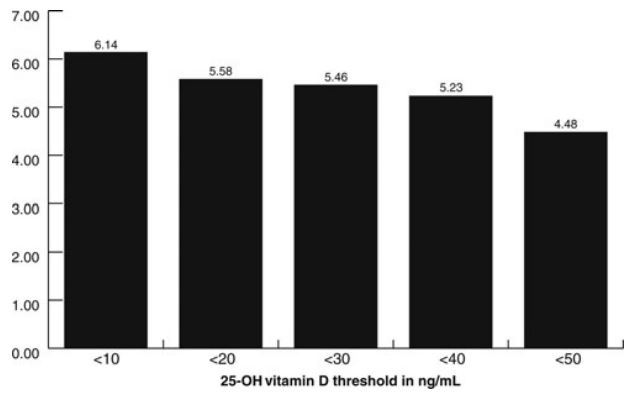More likely to report that productvitiy was effected by health problems if low vitamin D - 2012
Impact of Vitamin D Deficiency on the Productivity of a Health Care Workforce.
J Occup Environ Med. 2012 Jan 20. 10.1097/JOM.0b013e318240df1e
Plotnikoff GA 1, Finch MD 2, Dusek JA 3.
1 3 Center for Health Care Innovation and Penny George Institute for Health and Healing
2 Allina Hospitals and Clinics; and University of Minnesota Carlson School of Management, Minneapolis, Minn.
OBJECTIVE: To define the relationship between vitamin D status and employee presenteeism in a large sample of health care employees.
METHODS: Prospective observation study of 10,646 employees of a Midwestern-integrated health care system who completed an on-line health risk appraisal questionnaire and were measured for 25-hydroxyvitamin D.
RESULTS: Measured differences in productivity due to presenteeism were 0.66, 0.91, and 0.75 when comparing employees above and below vitamin D levels of 20 ng/mL, 30 ng/mL, and 40 ng/mL, respectively. These productivity differences translate into potential productivity savings of 0.191%, 0.553%, and 0.625%, respectively, of total payroll costs.
CONCLUSIONS: Low vitamin D status is associated with reduced employee work productivity. Employee vitamin D assessment and replenishment may represent a low-cost, high-return program to mitigate risk factors and health conditions that drive total employer health care costs.
📄 Download the PDF from Sci-Hub via Vitamin D Life
This study was cited 16 times as of July 2021
Employees: 10,500, mainly white female nurses
Employees were asked to rate, on a scale of 0-10, how much health problems during the past week had effected their productivity.
Results of vitamin D blood test: average 29 ng, with 29% < 20ng, 6% < 10 ng
The results varied, not unexpectedly, inversely with their vitamin D levels, that is, the more that health affected their work, the lower their vitamin D levels
More likely to report that productvitiy was effected by health problems if low vitamin D

< 20 ng = 5.6; < 40 ng = 4.5 (on a scale of 0-10)
Perspective on presenteeism
5% for this study of health care employees – who had paid sick leave!
2% for healthy populations
29% for those with allergies
40% for individuals with pain
This study does not apply to those who no paid sick leave (30%),
or who have used up all of their sick leave
Unlikely that chronic pain was considered by the survey
Benefits to employers include
- Less Sick leave - both due to decreased sickness by employee and family
- It the spouse or children get sick an employee may take "personal leave"
- Sick leave incurs cost to hire a temp replacement who is typically less productive
- Employee will get back to work more quickly after a sickness, hospital procedure
- Less sickness while on the job
- this presenteeism study shows productivity lowered even more if present if they have low vitamin D
- if the employee sickness is contagious it can spread to co-workers (colds, flu)
- Less health care costs for the individual
- which should result in decreased health care premiums for the smaller employers
Might get 5% employer benefit if get most employees and families to increase vitamin D
Employers might focus on employees where they would get the most benefit
Essential employees (managers, and others for whom a temp is not possible)
Employees with dark skins
Employees who are over-weight
Employees who have already had vitamin D-related medical problems
Employees who especially get colds and the flu in the winter
Employees who are > 55 years old
- Seniors get about 1/4 as much vitamin D from the sun as juniors
- Vitamin D will reduce sickness AND restore their cognitive abilities
Employees who work 3rd shift
Employees who work far from the equator and get less sun (for very large companies)
Employees who work in areas with extremely hot sun (Phoenix, Middle East)
- Employees avoid the hot sun so much that they often have very low levels of vitamin D - in the summer!
- Employees who are pregnant
- Less sick leave, less complications from pregnancy, less trouble with the new-born
Real employee costs consists of many things - some costs are reduced by vitamin D
- Hiring/ Recruiting – turnover (25% to 200% of annual salary)
- employee stays with employer who is concerned his health
- employee does not have to leave to to his own illness or illness in immediate family
- lost productivity as replacement comes up to speed, training, moving,
Retirement pension - healthier person has fare fewer major health expenses
Health insurance (single vs family) - small employers can get lower cost on healthy group insurance
Sick leave - less sick leave taken for employee or family illness
Vacation pay
Medicare 2.9% (employee + employer)
Holiday pay
Unemployment insurance
social security
workman's compensation (0.3% to 7.5%)
See also Vitamin D Life
- Companies and individuals will benefit from more vitamin D
- which includes the following costs of obesity:
- Medical Costs, Productivity, Absenteeism, Presenteeism , Disability, Premature mortality, Additional cost of health insurance,
Cost Savings with Vitamin D category listing has items along with related searches
Plotnikoff
Doctor Plotnikoff wants to put vitamin D to work in the workplace – Feb 2012
Google Search for Plotnikoff in Vitamin D Life 393 hits as of Sept 2018
Vitamin D Replentishment – Feb 2012 by Plotnikoff
Vitamin D Deficiency: Time for Inaction (question mark)– Jan 2014
Page was renamed Sept 29, 2018. There have actually been visitors to this page
